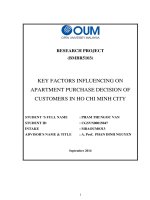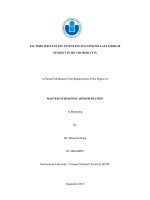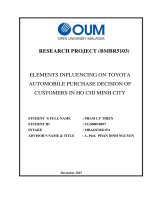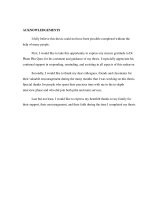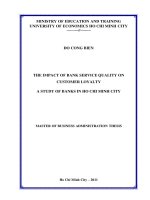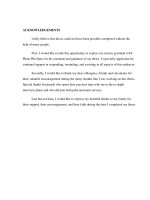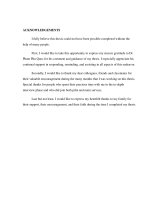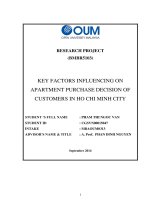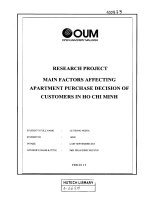Elements influencing on toyota automobile purchase decision of customers in ho chi minh city
Bạn đang xem bản rút gọn của tài liệu. Xem và tải ngay bản đầy đủ của tài liệu tại đây (866.74 KB, 83 trang )
RESEARCH PROJECT (BMBR5103)
ELEMENTS INFLUENCING ON TOYOTA
AUTOMOBILE PURCHASE DECISION OF
CUSTOMERS IN HO CHI MINH CITY
STUDENT ‘S FULL NAME
: PHAM LY THIEN
STUDENT ID
: CGS00018497
INTAKE
: MBAOUMK15A
ADVISOR’S NAME & TITLE
: A. Prof. PHAN DINH NGUYEN
December 2015
ADVISOR’S ASSESSMENT
............................................................................................................................................
............................................................................................................................................
............................................................................................................................................
............................................................................................................................................
............................................................................................................................................
............................................................................................................................................
............................................................................................................................................
............................................................................................................................................
............................................................................................................................................
............................................................................................................................................
............................................................................................................................................
............................................................................................................................................
............................................................................................................................................
............................................................................................................................................
Advisor’s signature
ACKNOWLEDGEMENTS
This research paper is made because of my passionate dedication to the continually
growing Automobile industry in Vietnam in the year to come. I would reserve a special
thanks to Mr. Aruth, who took me to the Automobile business industry in Vietnam 10
years ago and whom I lost contact. My thankful words would fly to Assoc. Pro Dr.
Nguyen Phan, who has instructed me during the course of this research. I also express my
thankfulness to Hutech and Malaysia Open University without whom my dream of getting
an MBA would not have come true.
This research would not have been done without great sacrifices from my family members,
who have been unconditionally motivating and supporting me during the last 15 months of
the MBA program. Besides, all the classmates are another stream of encouragement for me
to get inspired of this program.
Pham Ly Thien
December 2015
1
ABSTRACT
The main goal of the study was to examine main elements influencing consumer
purchasing decisions in Ho Chi Minh City‟s Automotive industry. The study was instruted
by the following specific goals: to determine the economic factors affecting consumer
purchasing decisions in Ho Chi Minh city‟s automotive industry; to examine the
psychological factors affecting consumer purchasing decisions in Ho Chi Minh city‟s
automotive industry; to examine the social-cultural factors affecting consumer purchasing
decisions in Ho Chi Minh City‟s industry, and; to analyze the demographic factors
affecting consumer purchasing decisions in Ho Chi Minh city‟s automotive industry. The
study concludes that psychological factors, social-cultural factors, economic factors, as
well as demographic factors affect consumer purchasing decisions in Automotive industry
in Ho Chi Minh city.
It was important to understand the little things that consumers use as the basis for making a
judgment of when it comes to purchasing decisions. The study recommends the need for
automobile companies to consider consumers‟ demographic characteristics such as age,
gender, marital status, occupation, education and income when designing the products to
offer into the Ho Chi Minh city market. This is because demography factors are vital
and measurable statistics of a population that helps to locate target market, they are easier
to measure and are suitable for psychographic and socio-cultural studies. Additionally
demographic factors have a huge impact on the assessment of different features which are
generally associated with consumer behaviour.
2
CONTENTS
ADVISOR‟S ASSESSMENT
ACKNOWLEDGEMENTS
ABSTRACT
LIST OF TABLE ............................................................................................................ 3
CHAPTER 1. INTRODUCTION .................................................................................. 6
1.1. BACKGROUND ................................................................................................... 6
1.2. PROBLEM STATEMENT ................................................................................. 10
1.3. RESEARCH OBJECTIVES ................................................................................. 12
1.4. RESEARCH QUESTIONS ................................................................................. 13
1.5. SCOPE OF STUDY ............................................................................................ 13
1.6. DEFINITION OF TERM ..................................................................................... 14
1.7. RESEARCH STRUCTURE ................................................................................ 15
1.8 CHAPTER OVERVIEW...................................................................................... 15
CHAPTER 2. LITERATURE REVIEW ..................................................................... 17
2.1. INTRODUCTION ............................................................................................... 17
2.2. ECONOMIC FACTORS .................................................................................... 17
2.2.1.
Level of Income ............................................................................................... 17
2.2.2.
Interest Rate .................................................................................................... 19
2.2.3.
Fuel Prices ....................................................................................................... 20
2.2.4.
Price of Car ..................................................................................................... 20
2.3 PSYCHOLOGICAL FACTORS .......................................................................... 22
3
2.3.1
Perception ......................................................................................................... 25
2.3.2
Learning ............................................................................................................ 26
2.3.2
Related Utilities ................................................................................................ 26
2.4 SOCIAL – CUTURAL FACTORS ...................................................................... 27
2.4.1
Religion ........................................................................................................... 29
2.4.2
Family ............................................................................................................... 29
2.5 DEMOGRAPHIC FACTORS ................................................................................ 30
2.5.1
Gender Differences ........................................................................................... 31
2.5.2
Age Differences ................................................................................................ 32
2.5.3
Changing Life Events ....................................................................................... 33
2.6 PURCHASE DECISION ....................................................................................... 34
2.7. CONCEPTUAL FRAMEWORK ......................................................................... 34
2.8 CHAPTER SUMMARY ........................................................................................ 35
CHAPTER 3. RESEARCH METHODOLOGY ......................................................... 36
3.1. INTRODUCTION ............................................................................................... 36
3.2. REASEARCH DESIGN ....................................................................................... 36
3.3. POPULATION AND SAMPLING DESIGN ...................................................... 37
3.3.1.
Population ....................................................................................................... 37
3.3.2.
Sampling Design ............................................................................................. 37
3.4. DATA COLLECTION METHODS..................................................................... 38
3.5. RESEARCH PROCEDURES ............................................................................. 39
3.6 DATA ANALYSIS METHODS .......................................................................... 39
3.7. CHAPTER SUMMARY ...................................................................................... 40
4
CHAPTER 4. RESULTS AND FINDINGS ................................................................ 41
4.1. INTRODUCTION ................................................................................................ 41
4.2. BACKGROUND INFORMATION ..................................................................... 41
4.3. ECONOMIC FACTORS AND PURCHASING DECISION .............................. 47
4.4
PSYCHOLOGICAL FACTORS AND PURCHASE DECISION ..................... 49
4.5 SOCIAL-CULTURAL FACTORS AND PURCHASE DECISION................... 51
4.6 DEMOGRAPHIC FACTORS AND PURCHASE DECISION ......................... 53
4.7. HYPOTHESES TESTING BY MULTIPLE REGRESSION .............................. 58
4.8. CHAPTER SUMMARY .................................................................................... 58
CHAPTER 5. DISCUSSION, CONCLUSION AND RECEMMENDATIONS ........ 59
5.1. INTRODUCTION ............................................................................................... 59
5.2. SUMMARY ......................................................................................................... 59
5.3. DISCUSSION ....................................................................................................... 60
REFERENCES ............................................................................................................. 70
Appendix 1: English questionnaire ............................................................................. 73
Appendix 1: Vietnamese questionnaire ....................................................................... 78
5
1.0 INTRODUCTION
1.1 BACKGROUND TO THE STUDY
Consumer behavior is regarded to be that particular the action which an individual takes in
the process of purchasing and using products and services. This process also includes the
mental as well as the social processes which come before these actions. It means therefore
that one of the biggest challenges facing businesses is the process of predicting and
understanding consumer behavior. At present, the competitive market forced producers to
produce goods based on customer needs (Tafler, 2014). The study of consumer purchase
behavior, which was initially known as consumer behavior, offers relevant information
regarding consumers and their consumption patterns.
An organization can actually survive if it can be able to supply consumer needs
and demands with a comprehensive understanding of them. This means therefore that
there is need to study consumer behavior. In this regard, there is need to understand
consumer behavior which is not so simple. Customers likely do not know their own
deeper inner motivation or they are likely therefore to react to affecting factors in the last
moment, and this can simply change their mind. However, marketers need to consider
their customers‟ requests, intakes and buying behaviors (Kotler, 2009).
Knowledge of consumer behavior is therefore considered to be very essential if
organizations seek to gain commercial success. The relationship between consumer
behavior as well as marketing strategy is very much emphasized since the success of
6
companies‟ marketing strategies depends on how well managers‟ understand of consumer
behaviour (Kotler, 2009).
Consumer buyer behavior is regarded to be the multi-step decision-making process where
people take part in it and it also include the actions consumers take to satisfy their needs
and wants in the marketplace. The study of customer behaviour is therefore mainly
focused on consumer buying behaviour, in that the customer plays three essential roles:
user, payer as well as buyer (Kotler, 2009).
According to previous studies conducted on consumer behavior it has not been easy to
predict what goes through the mind of the consumers during the purchase decision. This is
because it involves the psychological processes which consumers undergo in recognizing
their needs, while seeking ways to solve these needs, making purchase decisions,
interpreting information, making plans, and finally implementing these plans.
One of the most fundamental assumptions in the study of consumer behaviour is that
indeed individuals often buy products on the basis of their perceived values as compared
to their primary functions (Stávková, Stejskal & Toufarova, 2009). This however is not to
say that that the main functions of the products are not essential. However it simply means
that the contemporary duty of a product is more when compared to its basic use-value. In
most cases, consumers do not rate products in relations to their core attributes but,
rather according to the so-called real product as well as the extended product, which
simply represents a set of intangible factors, which confer a desired perceived advantage
7
on the consumer and which includes; image consultancy, and after-sale service (Foret
& Procházka, 2009).
Consumer buying behavior is often unconsciously affected by some factors. For instance
social factors play an essential role when it comes to the decision of buying certain
products, including the most sensitive products such as cars. The important social factors
are: reference groups, family, role and status. There are four important psychological
factors affecting the consumer buying behavior: perception, motivation, learning and
beliefs and attitudes. The economic factors that most commonly affect consumer behavior
include occupation, economic situation and personality (Blythe, 2009).
Successful businesses are well aware of how to leverage the different factors that
influence consumer buying behavior in order to effectively market their products
and as such maximize sales. Studies have revealed that there are generally four main
factors that play a role in the consumer's buying behavior. The factors include cultural
factors, social factors, personal factors and psychological factors (Blackwell et al., 2001).
This study therefore sought to explore of the four main factors that influence consumer
buying behavior of the automotive.
A study done by Havkinze, Roger & Kenth (2009) was able to establish that the
consumer‟s disposable income is indeed very essential when it comes to determining what
to buy and in what quantities, however this mostly depends on the income elasticity of a
certain product. In the event that the consumers disposable income increases and that the
income elasticity of demand for that good is greater than one then the proportional rise in
8
the demand for that product is greater than the rise in income levels. Their study also
reported that the influence of culture on buying behavior varies from country to country
therefore marketers have to be very careful in analyzing the culture of different groups,
regions or even countries.
Peter & Olson (2009) are of the opinion that customer possesses specific belief and
attitude towards various products. This is because such beliefs and attitudes are what
comprises brand image and therefore affect consumer buying behavior. In this regard, it is
important for marketers to change the beliefs and attitudes of customers through the
launch of special campaigns.
According to Experts, Vietnam‟s automotive industry will have the fastest growth in
Southeast Asia over the next 20 years. This growth will be the result of increasing
consumer demand, a young workforce, and strong governmental support for the industry.
It has been predicted that Vietnam‟s automotive industry will annually produce 220,000
units by 2016 and 1.5 million units by 2020. Vietnam‟s Automobile Manufacturers‟
Association (VAMA) has produced similarly rosy numbers.
In 2014, there were 157,810 vehicles sold in the country, this was a 43 percent year on
year increase. Breaking these numbers further down, there was a 43 percent increase in the
sale of personal cars, with 100,000 units sold, and a 42 percent increase in truck sales,
with 57,371 vehicles sold.
9
The Automotive industry in Vietnam in general, and in Ho Chi Minh City in particular is
primarily involved in the retail and distribution of motor vehicles. There are a number of
motor vehicle dealers operating in the country, with the most established being. There are
also three vehicle assembly plants in the country, which concentrate on the assembly of
pick-ups and heavy commercial vehicles.
The main brands category from Toyota Vienam sold in Ho Chi Minh City are; Corolla,
Toyota 86, Yaris, Vios, Camry, Innova Fortuner, Prado, Hilux, Hiace and Land Cruiser.
Toyota Vietnam employs approximately 1,900 employees in the various branches Data
from the Vietnam Automotive Manufacturers Assosiation (VAMA) shows that Toyota‟s
market share is more than 50 per cent.
1.2 PROBLEM STATEMENT
The behavior of the consumer with regard to purchase of automotive is affected by various
factors that are uncontrollable; cultural, social, personal and economical and psychological
factors. These factors cause consumers to develop products and brand preferences.
Although many of these factors cannot be directly controlled by marketers, understanding
of their impact is essential as marketing mix strategies can be developed to appeal to the
preferences of the target market (Ahmed and d‟Astou, 1993).
Today‟s competitive world chance of survival of automotive companies is related to
continually providing its customers‟ satisfaction and to attract their loyalty and support.
Knowing the factors that unconsciously affect the decision to purchase something can
have positive effects on supplying the customers with better products. Consumer behavior
10
means more than just how person buys products. Marketing efforts therefore also focus on
consumer‟s consumption of services, activities and ideas. The manner in which consumer
buys is extremely important to marketers. It involves understanding the set of decisions
(what, why, when, how much and how often) that consumer makes over the time (Hoyer
2004). It is important to know how consumer reacts towards different product features,
price, and advertisement, in order to ensure strong competitive advantage (Khachaturian
and Morganosky, 1990) and (Ahmed and d‟Astou, 1993).
Toyota is no exception for every potential buyer has to consider various factors before a
purchase of their product. For the company to remain competitive in the motor industry in
Vietnam; there is need for the management to understand their customers buying behavior
towards their automotive brands as well as how consumer reacts towards different product
features, price, and advertisement, in order to ensure strong competitive advantage.
However, there has been not enough research into the way customers making decision to
buy cars as well as which major factors have got relationship with customer decision.
In practice, beside of problems raised above, there are many limitations that the thesis
would study after defining and collecting opinions and contribution through research
methodology conduct. This research is supported to capture the key factors influence on
demand of people in choosing Toyota cars for driving in HCM City.
This study, therefore sought to fill this information gap by investigating the factors that
influence customer buying behavior of the motor industry.
11
1.3.
RESEARCH OBJECTIVES
The study was guided by the following specific objectives:
1.3.1 To determine the economic factors affecting consumer purchasing decisions in
Ho Chi Minh city for Toyota Automobile.
1.3.2 To examine the psychological factors affecting consumer purchasing decisions in Ho
Chi Minh city for Toyota Automobile.
1.3.3 To examine the social-cultural factors affecting consumer purchasing decisions in
Ho Chi Minh city for Toyota Automobile.
1.3.4 To analyze the demographic factors affecting consumer purchasing decisions
in Ho Chi Minh city for Toyota Automobile.
The objective of thesis aims to conduct a survey on Toyota Cars prefererences (Toyota 86,
Yaris, Corrola, Vios, Camry, Innova, Fortuner, Hilux, Hiace, Prado and Land Cruiser) of
people in Ho Chi Minh City and examine difficulties, challenges in choosing Toyota Cars
for long term Usage.
The thesis aims to understand buying behavior of people in HCM City by studying their
decision making process and type of buying behavior.
This thesis will conduct studying any influence both positive and negative that may
impact on purchasing decision of Toyota Cars.
12
Understanding relationship between main factors affecting customer Toyota Cars purchase
decision is an important role for both Automotive developers and enterprises to satisfy
customers‟ demand and to have available strategies in the Automotive field.
1.4.
RESEARCH QUESTIONS
Currently, in the term of Toyota Car purchase decision of customers, the research
questions of the thesis are raised as two following questions:
What are main factors influencing on Toyota Car purchase decision of
customers in HCMC. ?
How is impact of these factors on Toyota Car purchase decision of
customers evaluated in HCM context?
Understanding relationship between main factors affecting customer purchase decision is
an important role for Toyota firms to satisfy customers‟ demand and to have available
strategies in the Automotive field.
1.5.
SCOPE OF STUDY
The survey has been conducted within November 2015 in Ho Chi minh City. Toyota Car
Dealers will be involved in the survey as following:
+ An Thanh Toyota (ASTA), 606 Tran Hung Dao-Distict 5
+ Ben Thanh Toyota (TBTC), 262 Tran Hung Dao- District 1
+ Dong Saigon Toyota (TESC), 507 Xa Lo Ha Noi- An Phu Ward, District 2
+ Dong Saigon Toyota– Go Vao Branch, 18 Phan Van Tri, Go Vap District
+ Tsusho Toyota (TTSAMCO), 26 Kinh Duong Vuong, District 6
+ Ly Thuong Kiet Toyota (TLTK), 151A Ly Thuong Kiet, Tan Binh
+ Hiroshima Tan an Toyota (THTC), 220 Bis Dien Bien Phu, Binh Thanh Dicstrict
+ Phu My Hung Toyota (TPMH), 806 Nguyen Van Linh, District 7
+ An Suong Toyota (TAS), 382 Highway 22, District 12
13
The study is important in order to provide information to automotive Companies in Ho
Chi Minh City especially when it comes to selling their automotive products; this
automatically taps into their strategic goals.
This study will also be beneficial to the consumers in that they will have more knowledge
about motor vehicle products and the importance of motor vehicles, they will also learn
about the different factors affecting their buying decisions.
This study will also be helpful to other researches and academic institutions to learn about
Ho Chi Minh city‟s Automobile industry. This study will also be the centre piece idea to
other students willing to pursue a research on a similar field. This is so because the final
draft of the completed research will provide further areas of research.
The study was conducted on consumer buying behaviour of Automobile vehciles in Ho
Chi Minh City. This study was based on all 9 Toyota Car Dealer for customers in Ho Chi
Minh city. It included a target market of people ranging from ages 19 – 60 who have
disposable income to spend on Automobile vehciles, it targeted both walk in clients and
existing clients.
The limitations of the study was the fear of ananymity on the side of the respondents. This
was however eliminated by the assurance that the study was for academic purposes and
that the findings was not to be shared to any other party.
1.6 DEFINITION OF TERMS
1.6.1 Consumer buyer behavior
This refers to the multi-step decision-making process people engage in and the actions
they take to satisfy their needs and wants in the marketplace (Kotler, 2008).
1.6.2 Economic Factors
According to Brassington (2011), economic factors include among others; the level
14
of income, credit availability, attitude towards spending, liquid assets.
1.6.3 Socio cultural factors
Social cultural factors include a number of factors that characterize the relationships and
activities of a group of people within a particular set environment (Jones, 2007).
1.6.4 Psychological factors
The term psychosocial refers to the psychological and social factors that influence mental
health (Smith, 2009).
1.6.5 Demographic Factors
This includes age, occupation, family size and family life cycle and sex of the individual
(Kotler, 2008).
1.7 RESEARCH STRUCTURE
This chapter provides a background of the problem followed by the statement of
the problem. Thereafter, research objectives are provided, followed by significance of the
study in that order. Chapter two will provide literature review organized in terms of the
research objectives. In chapter three, research design, methodology, as well as the data
type and the data collection instruments are explained. Chapter four will provide the study
findings in terms of descriptive and logic regression results based on the study objectives.
Chapter five will provide the summary as well as conclusions and recommendations.
1.8 CHAPTER OVERVIEW
This thesis consists of chapters including:
Charter 1: Introduction. This chapter is to present the general introduction of
Automotive demand and overview of Vietnamese Automobile industry with customers at
Toyota Car Dealer in Ho Chi Minh City particularly. The problem statement and
objectives of study are described in this chapter in details.
15
Charter 2: Literature Review. The conceptual framework of key factors of Toyota Car
preference pattern; car purchasing intention, decision making process are described and
the previous model/research to support for proposal hypothesis and research model for
this study.
Charter 3: Research Methodology. This chapter describes the research methodology and
to develop the process study, measurement scale, sampling plan and the method of
analysis and testing hypothesis.
Charter 4: Data analysis & Results. This chapter presents the result of research such as
statistical analysis and discussion.
Chapter 5: Conclusions & Implications. This chapter presents the main findings and
managerial implications. Besides, the limitations and further studies are also shown.
16
CHAPTER 2. LITERATURE REVIEW
2.1 Introduction
In this chapter, literature is reviewed based on research objectives. To start with,
reviewed relevant literature relating to the economic factors affecting consumer
purchasing decisions in Ho Chi Minh City‟s Automotive industry then the
psychological factors affecting consumer purchasing decisions in Ho Chi Minh city‟s
motor vehicle industry as well as the social-cultural factors affecting consumer
purchasing decisions in Ho Chi Minh city ‟s Automotive industry and finally the
demographic factors affecting consumer purchasing decisions in Ho Chi Minh City‟s
Automotive industry.
2.2 Economic Factors Affecting Consumer Purchasing Decisions
2.2.1 Level of Income
One essential economic factor that influences consumer buyer behavior is income. This
mainly because the amount of goods bought by a consumer as well as the type bought
differs depending on the wage which a consumer earns. In the event that a buyer has
greater income, chances are very high that such a consumer will go for more luxury
goods like high- end cars. Taylor (2011) is of the opinion that a reduction in income
shifts purchasing behavior from buying normal goods to inferior goods. This simply
means that as consumers buy fewer specialty items, such as shoes and clothing, and
buy more store-brand items.
Mogridge (2009) posits that the main essential concept when it comes to consumer
buyer behavior is that the average person of a given income level is likely to spend a
given quantity of money on the purchase of cars. He therefore goes ahead to argue that
there is a function which gives, for every income level, as well as an average
expenditure on a car purchase. More recent studies that have been conducted in this
area have shown that there is a positive relationship between income levels and vehicle
17
purchase decisions by individuals (Feng, Wang & Zeng, 2011). For example, a study
conducted by Nagai, Fukuda, Okada, and Hashino (2013) revealed that two- and fourwheeled vehicle ownership in Thailand depends largely on the income levels of
individuals.
In another similar study Diaz-Olvera, Plat & Pochet (2008) and Blumenberg & Pierce
(2012) established that income or lack of it influences how a household purchases their
mode of transportation as well as the way in which individuals choose to travel. They
therefore are of the opinion that indeed low-income households are less likely to own
cars (Rahman, 2011) and more likely to travel by other modes of transportation other
than motor vehicle. This therefore means that the income level of an individual has a
positive relation with buying decision. It also means that individuals who have high
income are likely to buy expensive products.
Mathios (2012) on his part argues that family income level influences ones decision on
the choice of a motor vehicle to purchase. This indeed is a reflection of a high
efficiency in collecting information on motor vehicles. Such individuals are likely to
posses the financial support to purchase such vehicles and this therefore influences
them to buy more expensive cars whose price is higher. Gould and Lin (2014) on his
study established the level of income for an individual relates positively with health
knowledge, especially when it comes to choosing and potentially using motor vehicles
(Cotugna et al., 2012).
Some studies have shown that indeed income level plays a role in predicting consumer
awareness related to a person‟s attitude contraction. This is mainly because there
is a positive relationship between income growth and quality of car. This is therefore a
fundamental issue when it comes to consumers purchasing decision. The level of
income of an individual influences the willingness to pay marginally higher prices as a
social responsibility towards the motor vehicle. In other empirical studies carried
out in jurisdictions with low income per capital do not show any improvement in the
18
willingness to spend more on vehicles (Bloom & Sevilla, 2014). Therefore, the income
level moderates the relations between consumers behavior towards purchase decisions
of motor vehicles.
Gronmo (2008) has opined that individuals who are not able to fulfill their primary
needs, especially regarding self-esteem or self-actualization, are likely to compensate
these desires through alternative means.This
means
therefore
that
low-income
households, or those facing racial or ethnic discrimination, are more or less likely
spend heavily on socially visible products so as to make up for their lack of status in
society. In the event that traditional indicators of social status, such as wealth or
occupational prestige, are not accessible, people will without doubt resort to the
consumption of status products that are easily seen as symbols of a higher class (Fontes
& Fan, 2006).
2.2.2 Interest Rates
Interest rates are among one of the most influential factors when it comes to purchasing
decision for consumers. This is mainly because financial contracts for consumer
durables are mainly made up of multiple terms and conditions that include a price
(interest rate) as well as a payment period, which therefore makes it unlikely that the
financial costs of different contracts are exactly the same. Dasgupta, Siddart & SilvaRisso (2009) carried out an analysis of the behaviour of consumers with regards to
the choice of the funding method for automobiles (Banerjee, 2010).
They were able to compare the credit and leasing options. This study revealed
that consumers are very myopic and will therefore prefer contracts that come
with lower payment streams, even when they have higher total costs. They also
established that indeed most consumers are more likely to lease than to finance cars
with higher maintenance costs. This is simply because these options provide consumers
with the option to return the car before maintenance costs become too high. Wonder et
al., (2009) on the other hand opined that respondents preferred low interest rates, a high
19
rebate, and down payment. This view is contrary to that held by Doyle (2007) who
argues that an interest rate increase is likely not affect real motor vehicle sales if the
automakers are able to counteract the rate increases with lower prices.
2.2.3 Fuel Prices
McManus (2009) conducted a study to examine the link between fuel prices and sales
of cars and trucks in the U.S. In the analysis, He was able to show that economic
theory predicts a direct link between fuel prices and SUV sales, and more broadly
between fuel prices and vehicle sales. He therefore concluded that for an individual to
make a rational choice at the time of purchase, the shopper requires a prediction
(simple or sophisticated) of what future fuel prices are likely to be. He further
concluded that indeed a significant portion of changes in vehicle prices is likely to be
explained by changes in fuel prices. In effect, rising fuel prices lower the prices of
automobiles. This specifically, includes the negative impact of rising fuel prices on
vehicle prices is greater for less fuel efficient vehicles than for more fuel efficient
vehicles.
2.2.4 Price of the Car
Pricing is considered to be one among the four P's of the marketing mix (Brassington,
2011). It is therefore the manual or automatic process of applying prices to purchase
and sales orders, on the basis of factors such as a fixed amount, quantity break,
promotion or sales campaign, specific vendor quote, price prevailing on entry,
shipment or invoice date, combination of multiple orders or lines, and many others.
Automated systems therefore need to have more setup and maintenance but this is
likely to prevent pricing errors. The pricing technique used by most retailers is
cost-plus pricing. This involves adding a mark-up amount (or percentage) to the
retailers cost. This simply involves charging the amount suggested by the manufacturer
and usually printed on the product by the manufacturer (Jones, 2007).
20
A well-chosen price needs to be able to achieve the financial goals of the company
such as profitability. It should also fit the realities of the marketplace while at the same
time support a product's positioning and be consistent with the other variables in the
marketing mix. Price is largely influenced by the type of distribution channel used, the
type of promotions used, and the quality of the product. Price therefore needs to be
relatively high if costs incurred are high, distribution will without doubt be exclusive,
and the product is supported by extensive advertising and promotional campaigns. In
this regard therefore a low price can be a viable substitute for product quality, effective
promotions, or an energetic selling effort by retailers (Jobber, 2010).
In Turkey, Alper & Mumcu (2009) carried out an estimate on the demand for new
automobiles using quarterly data on price, quantity, quality, country of origin, and
product characteristics of the new automobile sales market demand during the period
1996-1999. He therefore established that the demand for new automobiles is price
inelastic in the short run. Similarly, Zhan & Vrkljan (2013) in South-Western Ontario
carried out a study on the older drivers‟ (70-90 years old) perceptions of vehicle safety
and how they influence their vehicle purchase.
The findings revealed that safety was superseded by other purchasing considerations most notably, price. Price was therefore identified and emphasized as the key
factor that influenced vehicle purchase decisions. Fuel efficiency, which participants
considered in their overall cost of the vehicle, was also listed as an important
consideration in the vehicle purchase decision process.
East (2014) argues that in traditional economics prices are simply treated as a cost.
This is because the recognition that a price merely serves to inform the consumer about
the good is more of recent origin. Price, one of the non-product attribute of brand
associations where it can be an important associations in the formation of brand
21
perceptions, particularly with regard to value and desirability and is a criterion by
which consumer often segment their knowledge of a market or category (Batey, 2009).
High quality products, as well as fancy packaging, exclusive store locations, high retail
margins, expensive promotions, advertising campaigns, notwithstanding brand names
are all seen to be the contribution to the higher prices of luxury goods. Companies
therefore go ahead to make large investments into these components in order to make
their products instantly recognizable and familiar. The luxury products are also likely
to lose their rarity and exclusivity characteristics if they are not priced high.
2.3 Psychological Factors Affecting Consumer Purchasing Decisions
2.3.1 Perception
Perception is regarded to be the energy that simply makes us aware of the world around
us and also goes ahead to attach a meaning to it after a sensing process. Human beings
in particular are able to view their surroundings differently. This is because different
people have the different ideas about a specific event. It means therefore that no one
can see or feel the 100% of all things. Ever wonder why people buy certain products?
It is all about perception. Perception is considered to be how consumers understand the
world around them on the basis of the information they receive through their senses. In
response to stimuli, consumers are likely to subconsciously evaluate their needs, values
and expectations, and then they use that evaluation to select, organize and interpret the
stimuli (Connolly, 2010).
The marketplace‟s perception of a brand or industry is considered to be very essential
which is why big brands work so hard to ensure that the general perception
surrounding them and their industry is as positive as possible. As a result, companies
like Gillette, will pay David Beckham to „model‟ their products. By aligning the way
people feel about Beckham, with the Gillette brand, Gillette can improve the
perception of their brand or reinforce what‟s already positive about it (Taylor, 2006).
22
A study carried out by Hawkins & Mothersbaugh (2010) was able to show that
perception begins with consumers‟ exposure and attention to marketing stimuli and
thereafter ends with their interpretation of the stimuli. Etzel, Walker & Stanton (2014),
on their side believe that consumers‟ perception is not only determined by the
characteristics of the stimuli, but it is also determined by the characteristics of the
consumer him or herself. It is therefore important for that marketers obtain a
thorough understanding of their target markets as well as how consumers will perceive
various marketing-related stimuli.
For example, Etzel et al., (2007) argues that the four elements of the marketing mix,
namely product, place, distribution and promotion, are likely to influence consumers‟
perceptions of the business, and therefore their selection. Manning & Reece (2007)
also opines that customers are likely to perceive the product‟s value on the basis of its
benefits which, in turn, is greatly influenced by the product‟s performance, features,
quality, warranties, packaging as well as labelling.
2.3.1.1 Perceived Quality
In Ho Chi Minh City markets, customers look for product quality and features that will
satisfy their needs. For example a vehicle is no longer seen to be just a means of
transport but has to emphasis on safety, durability, among other features like space,
seating capacity, 4WD or engine power and reliability among other features. The
massive literature has emphasized on actual quality and this has gone further to
conspire against what we describe as the neglected frontier of quality: an outside-in
perspective driven through the customer-centric perception of quality by intrinsically
dealing with the voice of the customer. The perception of the consumer regarding
quality of products has its own distinct definition and form of measurement. It
therefore goes a long way to touch on subjectivity, and is the level of perceived value
reported by the customer who benefits from a process or its outcome (Cronin &
23
